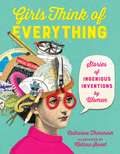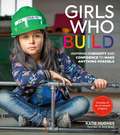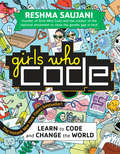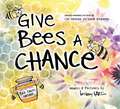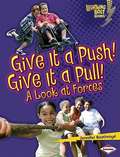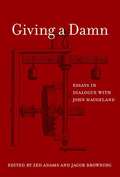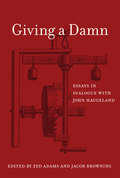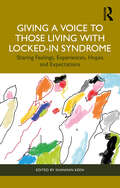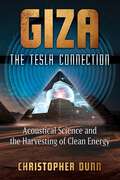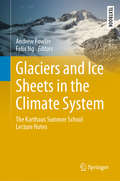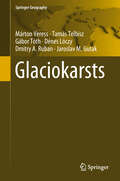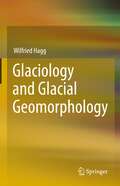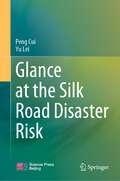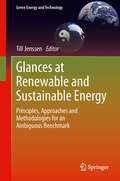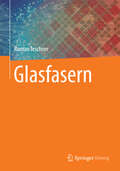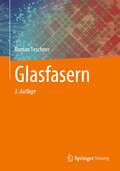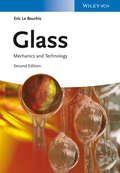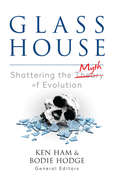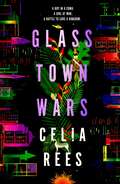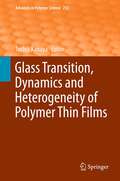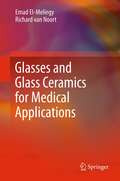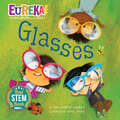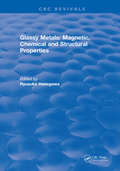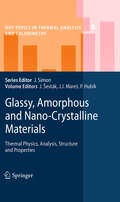- Table View
- List View
Girls Think of Everything: Stories of Ingenious Inventions by Women
by Melissa Sweet Catherine ThimmeshThis updated edition of the bestselling Girls Think of Everything, by Sibert-winner Catherine Thimmesh and Caldecott Honor winner Melissa Sweet, retains all the integrity of the original but includes expanded coverage of inventions (and inventors) to better reflect our diverse and technological world. In kitchens and living rooms, in garages and labs and basements, even in converted chicken coops, women and girls have invented ingenious innovations that have made our lives simpler and better. What inspired these girls, and just how did they turn their ideas into realities? <p><p> Retaining reader-tested favorite inventions, this updated edition of the best-selling Girls Think of Everything features seven new chapters that better represent our diverse and increasingly technological world, offering readers stories about inventions that are full of hope and vitality—empowering them to think big, especially in the face of adversity.
Girls Who Build: Inspiring Curiosity and Confidence to Make Anything Possible
by Katie HughesCelebrate the can-do attitude of fierce girls who know how to wield a hammer, fire up a saw, and build everything from a bookshelf to a playhouse. Featuring project photographs, this guide will inspire you to pick up your power tools and make something great.Carpenter Katie Hughes frequently found that she was the only woman on construction worksites. To change that, she began teaching classes to girls ages 8-14, showing them how to drill, saw, and weld. Her classes quickly became sold out summer camps and she founded her own non-profit, Girls Build.Girls Who Build features candid and arresting photographs of forty-five girls showing off their power tools and can-do attitudes. Accompanying each girl is a profile interview where she speaks to her inspirations and favorite builds, plus tips for others starting out. Also included are building skills, techniques, and safety tips to teach girls -- and older beginners -- how to handle hammers, drills, and saws plus thirteen do-it-herself building projects (from the featured girls themselves) such as picture frames, nightstands, playhouses, and more.
Girls Who Code: Learn to Code and Change the World (Girls Who Code #1)
by Reshma Saujani<P>Part how-to, part girl-empowerment, and all fun, from the leader of the movement championed by Sheryl Sandberg, Malala Yousafzai, and John Legend. <P>Since 2012, the organization Girls Who Code has taught computing skills to and inspired over 40,000 girls across America. Now its founder, Reshma Saujani, wants to inspire you to be a girl who codes! <P>Bursting with dynamic artwork, down-to-earth explanations of coding principles, and real-life stories of girls and women working at places like Pixar and NASA, this graphically animated book shows what a huge role computer science plays in our lives and how much fun it can be. <P>No matter your interest—sports, the arts, baking, student government, social justice—coding can help you do what you love and make your dreams come true. Whether you’re a girl who’s never coded before, a girl who codes, or a parent raising one, this entertaining book, printed in bold two-color and featuring art on every page, will have you itching to create your own apps, games, and robots to make the world a better place. <P><b>A New York Times Bestseller</b>
Give Bees a Chance
by Bethany BartonFrom the author-illustrator of Children's Choice Book Award Winner I'm Trying to Love Spiders: a plea to please give bees a chance!Not sure whether to high-five bees or run away from them? Well, maybe you shouldn't high-five them, but you definitely don't have to run away from them. Give Bees a Chance is for anyone who doesn't quite appreciate how extra special and important bees are to the world, and even to humankind! Besides making yummy honey, they help plants grow fruits and vegetables. And most bees wouldn't hurt a fly (unless it was in self-defense!). Bethany Barton's interactive cartoon-style illustrations and hilarious narrator mean this book is full of facts and fun. With bees officially on the endangered animals list, it's more important now than ever to get on board with our flying, honey-making friends!
Give It A Push! Give It A Pull!: A Look At Forces
by Jennifer BoothroydYou push a swing. Your brother pulls a wagon. Forces are at work all around you. But what exactly is a force? And how do forces act on different objects?
Giving a Damn: Essays in Dialogue with John Haugeland
by Jacob Browning Zed AdamsIn his work, the philosopher John Haugeland (1945--2010) proposed a radical expansion of philosophy's conceptual toolkit, calling for a wider range of resources for understanding the mind, the world, and how they relate. Haugeland argued that "giving a damn" is essential for having a mind -- suggesting that traditional approaches to cognitive science mistakenly overlook the relevance of caring to the understanding of mindedness. Haugeland's determination to expand philosophy's array of concepts led him to write on a wide variety of subjects that may seem unrelated -- from topics in cognitive science and philosophy of mind to examinations of such figures as Martin Heidegger and Thomas Kuhn. Haugeland's two books with the MIT Press, Artificial Intelligence and Mind Design, show the range of his interests.This book offers a collection of essays in conversation with Haugeland's work. The essays, by prominent scholars, extend Haugeland's work on a range of contemporary topics in philosophy of mind -- from questions about intentionality to issues concerning objectivity and truth to the work of Heidegger. Giving a Damn also includes a previously unpublished paper by Haugeland, "Two Dogmas of Rationalism," as well as critical responses to it. Finally, an appendix offers Haugeland's outline of Kant's "Transcendental Deduction of the Categories." ContributorsZed Adams, William Blattner, Jacob Browning, Steven Crowell, John Haugeland, Bennett W. Helm, Rebecca Kukla, John Kulvicki, Mark Lance, Danielle Macbeth, Chauncey Maher, John McDowell, Joseph Rouse
Giving a Damn: Essays in Dialogue with John Haugeland (The\mit Press Ser.)
by Jacob Browning Zed AdamsA collection of essays that use John Haugeland's work on intentionality, embodiment, objectivity, and caring to explore contemporary issues in philosophy of mind.In his work, the philosopher John Haugeland (1945–2010) proposed a radical expansion of philosophy's conceptual toolkit, calling for a wider range of resources for understanding the mind, the world, and how they relate. Haugeland argued that “giving a damn” is essential for having a mind—suggesting that traditional approaches to cognitive science mistakenly overlook the relevance of caring to the understanding of mindedness. Haugeland's determination to expand philosophy's array of concepts led him to write on a wide variety of subjects that may seem unrelated—from topics in cognitive science and philosophy of mind to examinations of such figures as Martin Heidegger and Thomas Kuhn. Haugeland's two books with the MIT Press, Artificial Intelligence and Mind Design, show the range of his interests.This book offers a collection of essays in conversation with Haugeland's work. The essays, by prominent scholars, extend Haugeland's work on a range of contemporary topics in philosophy of mind—from questions about intentionality to issues concerning objectivity and truth to the work of Heidegger. Giving a Damn also includes a previously unpublished paper by Haugeland, “Two Dogmas of Rationalism,” as well as critical responses to it. Finally, an appendix offers Haugeland's outline of Kant's "Transcendental Deduction of the Categories.” ContributorsZed Adams, William Blattner, Jacob Browning, Steven Crowell, John Haugeland, Bennett W. Helm, Rebecca Kukla, John Kulvicki, Mark Lance, Danielle Macbeth, Chauncey Maher, John McDowell, Joseph Rouse
Giving a Voice to those Living with Locked-In Syndrome: Sharing Feelings, Experiences, Hopes and Expectations
by Shannan KeenGiving a Voice to those Living with Locked-In Syndrome is a unique book that provides a way for the life experiences of people living with Locked-In Syndrome (LiS) to be heard. It combines the personal experiences of those living locked-in, with the biomedical aspects of LiS, including how it is diagnosed and treated, and the technology, such as eye-tracking devices and brain/computer interfaces, enabling those living with LiS to communicate.By highlighting both the positive and the negative elements of living with LiS, the book aims to encourage change, wherever it is needed in the field of LiS, to guide future diagnostic techniques and enable better, compassionate and appropriate care. Most importantly the book focuses on the moving autobiographies of people living locked-in. These personal accounts show their lives before becoming locked-in; their experiences during the illness or accident that resulted in LiS; how they came to terms mentally, emotionally and physically with their complete change in lifestyle; how those around them, their partners, family, friends and colleagues, adjusted; what is helpful to them and what is frustrating; and finally, their hopes for the future. Autobiographies are drawn from authors all over the globe, allowing readers insights into how LiS is dealt with in different countries, in terms of treatment, care and funding.It is valuable reading for all professionals working in the brain injury field, including neuropsychologists and those in the caring professions, as well as students in these fields. It will also be relevant for IT students and those working with new technologies.All royalty payments for this book are going to Mind Care International Foundation, a charity that provides information and support to patients and their families after brain injury.
Giza: Acoustical Science and the Harvesting of Clean Energy
by Christopher DunnReveals how the pyramids of Egypt were sophisticated generators of clean energy• Explains how the pyramids harmonized seismic energy, which enabled the harvesting of electricity and the mitigation of earthquakes• Shares recent cutting-edge research on earthquake lights, acoustic frequency measurements and energy concentration within the Great Pyramid, the shafts of the Queen&’s Chamber, the scorch marks that support the King&’s Chamber explosion hypothesis, and the significance of the large void above the Grand Gallery• Includes technical appendices written by experts and top researchersSharing extensive new evidence and cutting-edge research that the Great Pyramid at Giza was built as an energy-harvesting machine, Christopher Dunn details how the ancient Egyptians generated clean power for their civilization and reveals how the pyramid builders and the great inventor Nikola Tesla drew from the same universal knowledge. Looking at each part of the Great Pyramid, from the internal chambers to its massive stone blocks to the pyramidion on top, Dunn reveals how the pyramids in Egypt served to stimulate the release and collection of electrons in the Earth&’s crust by harmonizing seismic energy while also attenuating the accumulating stresses. Drawing on exhaustive ongoing research by NASA scientists into the phenomenon known as &“earthquake lights,&” Dunn shows how the pyramid builders were inspired by this phenomenon and learned to stress igneous rocks in order to harvest the resulting electron flow. He looks in depth at recent research that supports the pyramid energy theory, including new explorations of the shafts of the Queen&’s Chamber and analysis of the scorch marks on the ceiling of the Grand Gallery, which supports the King&’s Chamber explosion hypothesis. He examines the stunning significance of the large void above the Grand Gallery discovered in 2017. Dunn also analyses the results of extensive acoustic testing and measurements at ancient sacred sites and shows how the pyramids were tuned to the Earth&’s frequency. While the pyramids&’ sophisticated energy-harvesting abilities are now in disarray and disuse, some remnants of their technologies are still there, waiting to be rediscovered and provide our civilization with an abundance of nonpolluting power.
Glaciers and Ice Sheets in the Climate System: The Karthaus Summer School Lecture Notes (Springer Textbooks in Earth Sciences, Geography and Environment)
by Andrew Fowler Felix NgOur realisation of how profoundly glaciers and ice sheets respond to climate change and impact sea level and the environment has propelled their study to the forefront of Earth system science. Aspects of this multidisciplinary endeavour now constitute major areas of research. This book is named after the international summer school held annually in the beautiful alpine village of Karthaus, Northern Italy, and consists of twenty chapters based on lectures from the school. They cover theory, methods, and observations, and introduce readers to essential glaciological topics such as ice-flow dynamics, polar meteorology, mass balance, ice-core analysis, paleoclimatology, remote sensing and geophysical methods, glacial isostatic adjustment, modern and past glacial fluctuations, and ice sheet reconstruction. The chapters were written by thirty-four contributing authors who are leading international authorities in their fields. The book can be used as a graduate-level textbook for a university course, and as a valuable reference guide for practising glaciologists and climate scientists.
Glaciokarsts (Springer Geography)
by Márton Veress Dénes Lóczy Tamás Telbisz Gábor Tóth Dmitry A. Ruban Jaroslav M. GutakThis book discusses the theoretical and practical issues of glaciokarsts. After a research history, a general description of glaciokarsts is provided. Thereafter, the glacial erosion on karst, the karstic features of glaciokarsts, the development of these features, the karstic zones of glaciokarsts, surface development of glaciokarsts, case studies on glaciokarsts and an overview of the glaciokarsts of the Earth are presented.
Glaciology and Glacial Geomorphology
by Wilfried HaggThis textbook covers all important aspects of mountain glaciers, from their formation and their importance as water reservoirs to the threat posed by current global warming. Glaciers themselves can also pose a threat to humans and represent a natural hazard in populated mountain areas in the form of ice avalanches and glacial lake outbursts. In addition, however, they are also important landscape formers and have helped to shape large parts of the present-day relief of the Earth, which is one of the classic fields of work of geomorphology and geology.In the individual chapters, the current state of research is presented in a comprehensible manner and illustrated with concise examples, photos and graphics.The book offers a compact introduction for all students of geosciences, curious mountaineers and laymen interested in nature.
Glaciovolcanism on Earth and Mars
by Smellie, John L. and Edwards, Benjamin R. John L. Smellie Benjamin R. EdwardsThe study of volcano-ice interactions, or 'glaciovolcanism', is a field experiencing exponential growth. This comprehensive volume presents a discussion of the distinctive processes and characteristics of glaciovolcanic eruptions, their products, and landforms, with reference to both terrestrial and Mars occurrences. Supported by abundant diagrams and photos from the authors' extensive collections, this book outlines where eruptions have occurred and will occur in the future on Earth, the resulting hazards that are unique to volcano-ice interactions, and how the deposits are used to unravel planetary palaeoclimatic histories. It has a practical focus on lithofacies, glaciovolcanic edifice morphometry and construction, and applications to palaeoenvironmental studies. Providing the first global summary of past and current work, this book also identifies those areas in need of further research, making this an ideal reference for academic researchers and postgraduate students, in the fields of volcanology, glaciology, planetary science and palaeoenvironmental studies.
Glance at the Silk Road Disaster Risk
by Yu Lei Peng CuiThis book vividly shows the fostering environment, activity characteristics, distribution pattern, economic losses, casualties, disaster risks and management of earthquakes, mass movement, drought, floods, and marine disasters in the Silk Road region. It develops a multi-scale and multi-disaster risk assessment method to better assess and understand the Silk Road disaster risk. A multi-level collaborative risk management model has been proposed for transboundary disasters, and it also shares case studies on major disaster risk management. The book makes a major step forward to increase the understanding of the disaster risk of the Silk Road region. It presents a holistic understanding of the natural hazards and their induced disaster risks and is a valuable read for scholars, stakeholders and practitioners in the DRR community.
Glances at Renewable and Sustainable Energy: Principles, approaches and methodologies for an ambiguous benchmark
by Till JenssenDiffering interpretations, perspectives and expectations on the term sustainability exist. To take sustainability as an action guiding mandate for implementation it needs to be concrete and measurable as well it should weigh pros and cons. But how can such an integrated measurement in the field of renewable energy be conducted balancing the trade-offs between opposing indicators? Glances at Renewable and Sustainable Energy provides a thorough overview on the generic principles of sustainability assessment, including projective, thresholding and systemic principles and summarizes five common approaches for a holistic measurement. Approaches such as multi criteria decision analysis, ecological footprint analysis and normative-functional concepts are applied to different case studies in developed-, emerging and developing countries to cover a wide bandwidth of various renewable energy carriers under various conditions. Each case study includes 2 boxes illustrating the scheme behind the approach and exemplary calculations to allow a systematic comparison and a critical reflection of the methods applied. Compiling results on renewable energy assessment of the last decades, Glances at Renewable and Sustainable Energy gives researchers, students, consultants, politicians and entrepreneurs the tools to advance their oriental and instructional knowledge on sustainability and sustainability measurement, to reflect their decisions and tools for analysis and to transfer this knowledge into problem-solving.
Glasfasern
by Roman TeschnerDas Buch stellt eine wichtige Datenquelle von physikalisch-chemischen Eigenschaften der Fasergläser, Glasfasern und der für ihre Herstellung eingesetzten Glasrohstoffe und technologischen Prozessparameter dar. Es hilft dem Leser die Eigenschaften der Fasergläser und Glasfasern besser zu verstehen, um sie im Herstellungsprozess und in der Weiterverarbeitung optimal einzusetzen. Die Herstellprozesse der verschiedenen Glasfaserprodukte wurden in einer kompakten Form kurz und verständlich dargestellt. Das Buch kann sowohl den Glasfachleuten, den Compositsspezialisten, die in der Forschung und Entwicklung bzw. in der Produktion tätig sind, als auch Studierenden der Fachbereiche Glaschemie, Glastechnologie und Werkstoffwissenschaften sehr behilflich sein. Das Buch wurde von einem Praktiker geschrieben, der die Faserglasentwicklung und die Glasfaserproduktion sowie Faserziehprozesse über 20 Jahre aktiv begleitet und erforscht hat.
Glasfasern
by Roman TeschnerDas Buch stellt eine wichtige Datenquelle von physikalisch-chemischen Eigenschaften der Fasergläser, Glasfasern und der für ihre Herstellung eingesetzten Glasrohstoffe und technologischen Prozessparameter dar. Es hilft dem Leser die Eigenschaften der Fasergläser und Glasfasern besser zu verstehen, um sie im Herstellungsprozess und in der Weiterverarbeitung optimal einzusetzen. Die Herstellprozesse der verschiedenen Glasfaserprodukte wurden in einer kompakten Form kurz und verständlich dargestellt. Das Buch kann sowohl den Glasfachleuten, den Compositsspezialisten, die in der Forschung und Entwicklung bzw. in der Produktion tätig sind, als auch Studierenden der Fachbereiche Glaschemie, Glastechnologie und Werkstoffwissenschaften sehr behilflich sein. Das Buch wurde von einem Praktiker geschrieben, der die Faserglasentwicklung und die Glasfaserproduktion sowie Faserziehprozesse über 20 Jahre aktiv begleitet und erforscht hat. Dr. Teschner ist Autor von zahlreichen Patenten und Fachveröffentlichungen.
Glass
by Eric Le BourhisGlass is a material with essentially unlimited application possibilities. This second edition of a comprehensive reference in glass science, points out the correlation between the performance of industrial processes and practice-relevant properties, such as strength and optical properties. Interdisciplinary in his approach, the author discusses both the science and technology, starting with an outline of history and applications, glass structure, and rheology. The sections on properties include mechanical strength and contact resistance, ageing, mechanics of glass processes, the production and control of residual stresses, high-tech products, and current research and development. Applications include glazing, packaging, optical glass, glass fibers for reinforcement, and abrasive tools. The development of touchscreen technology showed how important were the design and resistance of thin flexible glass and these new thin aluminosilicate glasses are also discussed.
Glass House: Shattering the Myth of Evolution
by Ken Ham Bodie HodgeEvolution as an idea is considered a rock-solid truth among secular scientists, but when you begin looking at the evidence and asking simple questions, you find their conclusions to be just fragile assumptions, unproven myth, and outright misconceptions – like a glass house built on shifting sands. <P><P> Discover the pervasive influences of the atheistic religion of Darwinian evolution Learn what science is and how science is actually devastating to evolution Explore how evolution developed from unproven science to a popular and cultural worldview Now a powerful team of credentialed scientists, researchers, and Biblical apologists take on the pillars of evolution, and the truths they reveal decimate Darwin’s beliefs using a Biblical and logical approach to evidence.
Glass Town Wars
by Celia ReesThe thrilling adventure story based on the writings of the Brontë children, by the bestselling author of Witch ChildWhen Tom is in a coma, his friend Milo decides that he can be a guinea pig for a new gaming device - a device that will take him to a troubled world where he meets the the warrior-like Augusta who is fighting to save her kingdom from takeover by her rival. With Tom at her side, she finds extra courage. Slowly but surely, Tom starts to leave his life in London behind as the two of them become ever more embroiled in a world of chaos and tension that encompasses the past, the present and the future.But life in London won't let Tom go so easily. His friends and family gather around him to try and bring him back - as does a girl from school he barely knows, who comes each day to his bedside to read to him from her favourite book, Wuthering Heights.In this wonderful speculative fiction Celia Rees has created a meta-fictional world that will delight readers. This epic story, with Rees's trademark strong female character and romance at its heart, is a compelling action-driven adventure with delightful twists and turns that thrill and surprise right up to the last page.
Glass Transition, Dynamics and Heterogeneity of Polymer Thin Films
by Toshiji KanayaMobility Gradient of Polystyrene in Films Supported on Solid Substrates, by Yoshihisa Fujii, Hiroshi Morita, Atsushi Takahara and Keiji Tanaka Probing Properties of Polymers in Thin Films Via Dewetting, by Günter Reiter Heterogeneous and Aging Dynamics in Single and Stacked Thin Polymer Films, by Koji Fukao, Takehide Terasawa, Kenji Nakamura, Daisuke Tahara Heterogeneous Dynamics of Polymer Thin Films as Studied by Neutron Scattering, by Rintaro Inoue and Toshiji Kanaya
Glasses and Glass Ceramics for Medical Applications
by Emad El-Meliegy Richard Van NoortGlass ceramics are a special group of materials in which a base glass can be crystallized under carefully controlled conditions, which in turn determine the properties of the material. These materials offer a wide range of physical and mechanical properties combining the distinctive characteristics of sintered ceramics and glasses. This book provides readers with an interest in medical ceramics with the ability to start making their own glasses and glass ceramics, together with an understanding of the various factors that control the final properties of these medical and dental materials. In addition, the authors describe various industrial problems with current, clinically-used medical glass ceramics and discuss appropriate scientific solutions. Glasses and Glass Ceramics for Medical Applications will appeal to a broad audience of biomaterials scientists, ceramists, and bioengineers, particularly those with an interest in orthopedic and dental applications, as well as scientists and engineers involved in the manufacture of glasses, glazes, enamels, and other glass coatings for the medical materials industry. The book will also be of interest to undergraduate and graduate students in materials engineering and dentistry, and is suitable for use in courses on medical and dental materials.
Glasses: Eureka! The Biography of an Idea (Eureka! The Biography of an Idea)
by Lori Haskins HouranWithout glasses, everything can be a blur! Here is a "biography" of glasses, an essential invention that helps people see clearly.Ever since someone first noticed that a jar of water magnified what was behind it, people have worked to improve their vision. Glasses is a fun and informative look at an invention that makes a huge difference in our lives. This STEAM nonfiction title is part of the new Eureka! series, each book focusing on one groundbreaking, world-changing discovery that millions of people use every single day.
Glassy Metals: Magnetic, Chemical and Structural Properties
by Ryusuke HasegawaCovers: structure of metallic glass alloys; theory of magnetism in noncrystalline solids; electronic structure of metallic glasses; magnetism in transition metal base amorphous alloys; application of metallic glasses in low-frequency magnetic devices; magnetic material properties and applications of metallic glasses in electronic devices; rare-earth transition metal base alloys; corrosion properties of amorphous alloys.
Glassy, Amorphous and Nano-Crystalline Materials
by Jaroslav Šesták Jiří J. Mareš Pavel HubíkProvides a summary of non-equilibrium glassy and amorphous structures and their macro- and microscopic thermal properties. The book contains a carefully selected works of fourteen internationally recognized scientists involving the advances of the physics and chemistry of the glassy and amorphous states.
